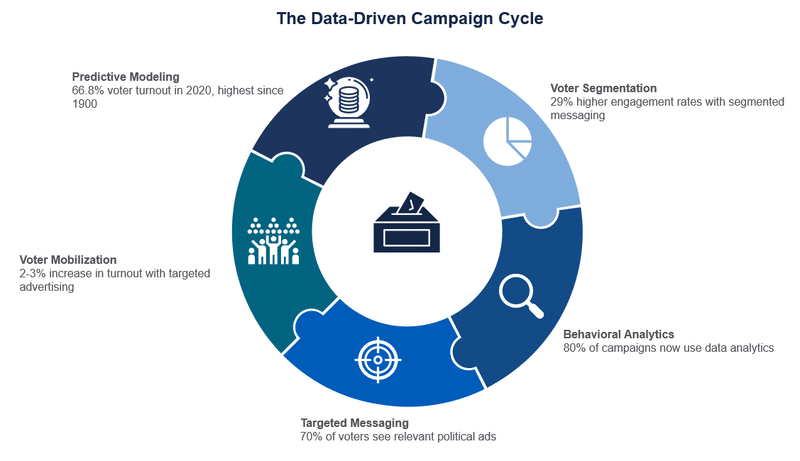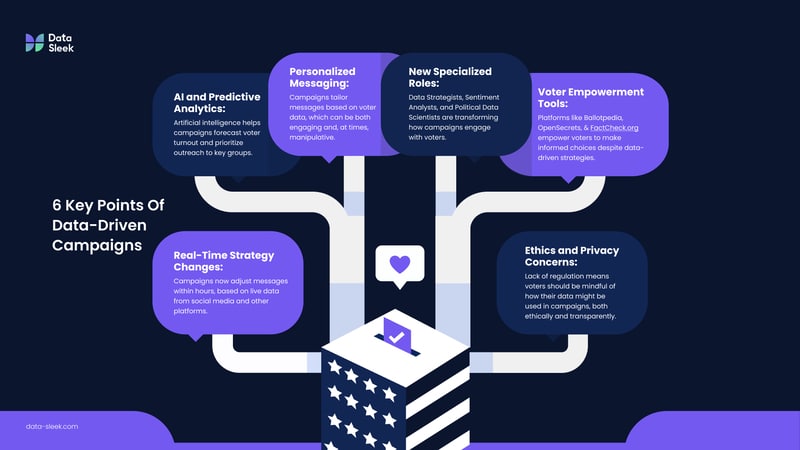Election season is winding down, with just a few days left until ballots are cast. If you’re feeling like this election has been anything but “normal,” you’re not alone. In many ways, this season has (once again) redefined the elections playbook, setting a new standard where the battlefield isn’t only on the ground—it’s in election data analysis.
Candidates are leaning on advanced data analytics to gauge voter sentiment, craft precisely targeted messages, and adjust their approaches almost instantaneously. Could this election hinge on which team has the better analytics strategy rather than the candidates themselves? Definitely, maybe.
The 2024 campaign trail includes high-tech “war rooms” and highly detailed voter profiles. Gone are the days when campaigns relied on sheer intuition and strong PR. Today’s campaigns use data-driven—and increasingly AI-driven—insights that are reshaping the way elections work and, by extension, shaping American democracy.
2024 Election By the Numbers:
- The 2024 United States Election is the most expensive political cycle in history with a total number exceeding $12.32 billion
- Political ad spending grew by 156.3% from 2020-2024 (as of September)
- Political ad spending for the first half of September amounted to $40.1 million for Harris and $7.9 million for Trump
Real-Time “War Rooms” and Strategy Adjustments
Imagine a high-tech command center with screens filled with charts, graphs, and social media feeds. What you are envisioning is a modern day “war room” used by both major political parties in the US. A war room is where a highly skilled political campaign team monitors public sentiment and adapts strategies in real-time.
These high-powered war rooms are where a mix of skilled professionals track trends on social feeds, news sites, comment sections, and even chat threads on forums like Discord and Reddit. Analysts can alert campaign teams to draft a quick response if a particular issue spikes. Quick, as in a matter of minutes to a matter of hours.
War rooms are not a new concept, nor are they a stranger to TV and film. You might remember the romanticized documentary The War Room (1993), featuring Bill Clinton’s campaign strategy or depictions in notable shows like The West Wing and The Newsroom.
Before 2008, war rooms consisted of highly credentialed data scientists, mathematicians, and analysts who manually crunched numbers from external poll data, focus groups, and media monitoring. Insights and response times took days, sometimes weeks, to respond to voter shifts.
Enter Dan Wagner.

How Dan Wagner Revolutionized Data Analysis For Elections
Modern war rooms first began with Obama’s campaign in 2008. Dan Wagner, the DNC’s targeting director, spearheaded the development of dashboards that modeled data. With the widespread use of the internet and social media gaining traction, the DNC had quicker access to more data that could be used in its predictive modeling solution, which Wagner affectionately called “Survey Manager.”
Wagner’s oversight of the project and its use led to successful predictions of congressional elections by a matter of 100 or so votes. For those who haven’t suffered through Stats III, that’s pretty damn accurate.
As election data analysis advanced, it eventually evolved into the ability to pull samples that could effectively be treated as representative of the whole. Wagner’s contribution redefined how campaigns used the web, social media, and smartphones to create targeted and efficient campaigns that eventually won Obama both elections.
Now in 2024, campaigns have created a unique dataset for each voter profile. These profiles contain hyper-detailed demographic and psychographic information that helps drive messaging and decision-making. While detailed, the sources and depth of this data is governed under data in election laws that restrict unfair use of voter data.
This pivotal innovation reflects more than an interesting shift—election data analysis enables you to turn the most volatile landscape in your favor, drive impact, and achieve desired results.
Sure, it sounds too good to be true. But it is true, and it’s led to a suite of new job roles in data strategy.
Want to drive impact in your organization? Talk to a data expert (not a sales guy) today
New job Roles in Data Strategy
The rise of data analytics in political campaigns has brought a wave of specialized roles now central to political campaigns. In 2012, the Obama campaign management built an analytics department five times larger than its 2008 campaign. In today’s election landscape, these analytics departments are continuing to expand with more unique roles new to the campaign trail.
Positions like Data Strategist, Sentiment Analysis Specialist, and Political Data Scientist that began under the Obama administration are now commonplace. However, roles like AI campaign strategists, microtargeting specialists, automation coordinators, and even AI content generators are new to the roster. Fueling the need for these positions is the growing need for data warehousing and AI-driven analytics teams to manage vast voter databases.

Marketing Strategy and Data Analytics in Political Campaigns
Modern campaigns use election data analysis to build precise voter profiles that go far beyond the basic demographics. This helps campaigns better understand which issues resonate with different groups. Campaigns gather anonymized data from brokers to understand trends, including browsing history, media engagement, and overall social interests.
Data from these brokers cover a surprisingly exhaustive profile, which helps identify patterns in their ideal audiences. These patterns help campaign strategists build a better picture of voter engagement and direct messaging toward the topics that matter most to their audience.
Predictive Modeling As A Secret Weapon
Predictive modeling is the tool of choice for voter profiling. Campaigns can use voter data to predict and test various scenarios that can make or break the election. And while predictive modeling isn’t better than actually calling and talking to a voter first-hand, it does give a pretty good idea of how likely a voter is to respond to the next ad rollout.
As election data analysis evolves, so does the ability to create hyper-targeted campaigns that can adjust to shifts in public sentiment almost instantly. Campaigns now rely on election data analysis not just to refine messaging but to craft personalized outreach that feels directly relevant to individual voters. This unprecedented level of targeting gives campaigns a powerful advantage, making every voter touchpoint more impactful and potentially more persuasive.
The Effects of Election Data Analysis and Voter Turnout
Data analysis has a profound influence on voter turnout, shaping not only how campaigns communicate but also whom they choose to engage. Through predictive modeling, campaigns can identify likely voters, those who may need a nudge to participate, and even individuals who may be persuaded to change their voting habits.
This targeted approach, powered by election data analysis, allows campaigns to allocate resources where they will have the most impact, potentially increasing turnout among underrepresented or overlooked demographics.

Crafting Tailored Messages to Motivate Voters
Beyond just identifying voters, data analysis can help craft messages that resonate with each group, tailoring outreach to address specific concerns or motivations. A campaign might identify that a particular demographic values economic policies or that another is highly motivated by social issues. By addressing these interests directly, campaigns can encourage voter registration and mobilize voters who may otherwise feel disconnected from the political process. Furthermore, data-driven insights allow campaigns to adapt in real time, launching turnout initiatives in areas with lower-than-expected early voting or adjusting tactics in response to live data on voter enthusiasm.
The rise of real-time election data analysis means that campaigns can monitor early voting trends and adjust their turnout strategies almost instantaneously. This feedback loop enables highly agile campaigns, using digital platforms, text messages, and even social media ads to reach voters when it’s most likely to influence their decision to vote. As election data analysis continues to evolve, its role in mobilizing voters will only grow, potentially increasing overall turnout and engaging segments of the population who may have felt disengaged in the past.
Ethics: Are Candidates Listening or Just Telling You What You Want to Hear?
As the role of data analytics evolves in political campaigns, questions around ethics grow louder. One concern is whether campaigns are authentic or simply telling you what you want to hear. Of course, there’s always the probability of over-tailoring messages to stroke your ears.
But there’s also the potential for something much greater. For the first time, campaigns can deeply understand what you care about. They can’t speak to every individual voter, but they can look at profiles representing your unique values. Campaigns now have the chance to uphold democracy by making elections more about people’s needs than the candidates themselves.
Data analytics can guide campaigns on which issues to prioritize, how to communicate effectively, and even how to foster trust. Used responsibly, data has the power to bring voters closer than ever to the candidates who truly represent them.
Making Campaigns More Efficient and Responsive Through Election Data Analysis
Data analytics don’t just help campaigns understand you better, they enable campaigns to run a more efficient, agile operation. Campaign teams access real-time data insights to help them make quicker and more informed decisions. If voter sentiment around an issue shifts, analytics give campaigns the power to pivot messaging within hours.
It was only in 2008 when Obama’s campaign really pioneered the use of social media analytics. By 2016, Big Data came on the scene. In 2020, campaigns only used basic social media analysis and traditional polling. The average response time for 2020 was quick, with an average of 2-6 hours of lag time, depending on the data set. In 2024, the introduction of real-time data is just that: results in real-time. With today’s sophisticated models, campaigns can use real-time data to take action at the first signs of a shift and long before things can get out of control.

First-Hand Experience From the 2008 Campaign Trail
To put it in perspective, I asked our esteemed colleague, Eva N., about her experience as a press writer during the 2012 U.S. Presidential Election. She shared insights into how data analytics and voter outreach have transformed over the years. The advancements in data-driven campaigning, she says, are “night and day” compared to what was possible back then.
“In 2012, we had the standard polling and demographic data to work with. Social media was more of a novelty,” she explains. “We would monitor Facebook and Twitter, but only to get a general sense of public sentiment. It wasn’t a sophisticated tool to gauge what entire groups were thinking. It was mostly intuition and experience guiding us.”
Twelve years ago, understanding voter behavior relied heavily on face-to-face interactions, focus groups, and limited polling. Data analytics was making strides, but its reach was still constrained. “We didn’t have real-time data at our fingertips. If there was a shift, or maybe a candidate made a detrimental statement, sometimes it took days for us to assess and react,” she notes.
For press writers like Eva, data analytics provides a game-changing level of insight that simply wasn’t available in 2012. Today, campaigns can gauge sentiment, test messages, and adapt strategies on the fly, she says, making them vastly more responsive to the public pulse.
“The landscape is unrecognizable,” Eva states. “Back then, we were breaking new ground. Now, campaigns can adjust in a matter of minutes. It’s crazy to see how much more agile and informed campaigns have become. Honestly, it might have changed past election results if we had the data we do today.”
Looking Towards the Future
Data analytics is no longer a tool—it’s the engine driving modern campaigns, shifting the core of elections from gut instincts to granular insights. In the near future, as AI advances and predictive algorithms become more refined, campaigns may not just gauge voter sentiment but anticipate it, creating strategies that evolve even before voter opinions fully crystallize.
This level of precision and responsiveness could reshape the very nature of political engagement, pushing candidates to become deeply attuned to public needs—or risk being left behind. As this technology progresses, election data analysis could transform from periodic snapshots of public will to continuous, data-driven dialogues, with analytics at the heart of a more responsive democracy.




